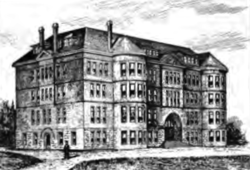Portland University

West Hall
|
|
| Type | Private |
|---|---|
| Active | 1891–1900 |
| Affiliation | Methodist |
| Location |
Portland, Oregon, United States 45°34′19″N 122°43′28″W / 45.57182°N 122.72431°WCoordinates: 45°34′19″N 122°43′28″W / 45.57182°N 122.72431°W |
| Fate | Campus became home to the University of Portland |
Portland University was a private, Methodist post-secondary school in Portland, Oregon, United States. Founded in 1891 in a split from Willamette University, the school closed in 1900. The campus was located in what is now the University Park neighborhood and later became home of the University of Portland. The original campus building, West Hall, still stands and is listed on the National Register of Historic Places.
Willamette University chancellor Charles Carroll Stratton founded the Methodist school in Portland in 1891. The school lured away some faculty members and students from Willamette, and even enticed Willamette’s president Thomas Van Scoy to serve as dean. In 1891, the school built the Administration Hall that became West Hall. Portland University opened in September 1891 with an enrollment of 256 students the first year. This was the only building on the campus with a nearby general store, Hemstock & Sons, serving as the bookstore.
Located at University Park, the school sold plots of property surrounding the campus to raise funds for the school. They had partnered with the Portland Guarantee Company to sell bonds, using the proceeds from the sale to buy 600 acres (2.4 km2) in what is now North Portland. This venture then deeded 71 acres (290,000 m2) to the school and sold plots for as much as $550. The location of the campus was on a bluff overlooking the Willamette River, with the river to the west. Much of the area was rural farmland at the time and local homes served as boarding houses for the students. Due to the remoteness, the school offered to have teachers meet new students at the streetcar stop located at University Park for the trek to the school. One impressive home in the area was the university president’s home, which was not on campus at the time.
Courses of study included Latin, science, art, and literature. The school grew to an enrollment of 500 by 1894 and included a literary department, a school of theology, music and fine arts department, and a college preparatory division. This last division had affiliations around the state with academies including Drain Academy, Lebanon Academy, Ashland Academy, and the La Creole Academy in Dallas.
...
Wikipedia
